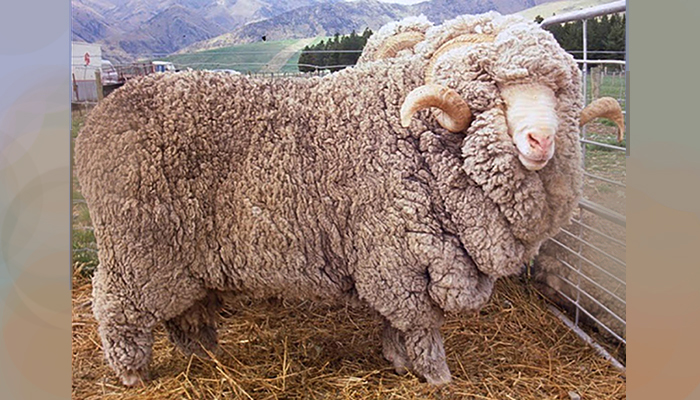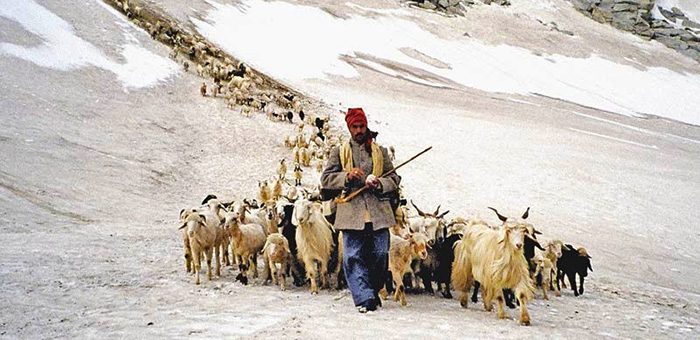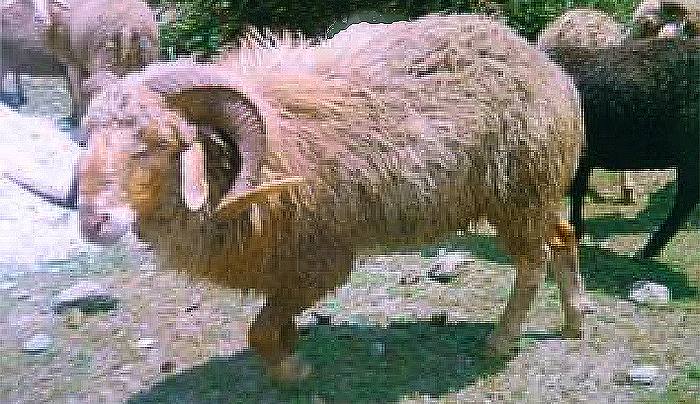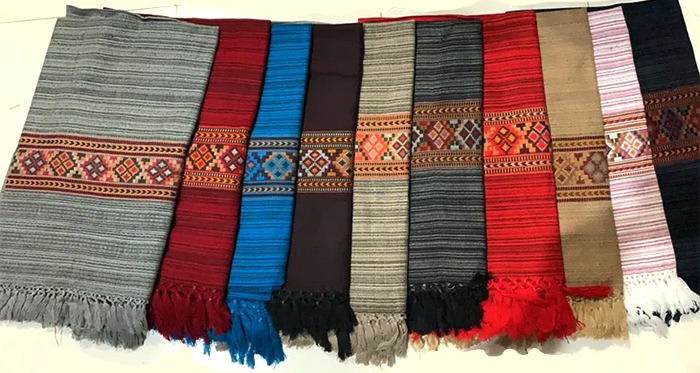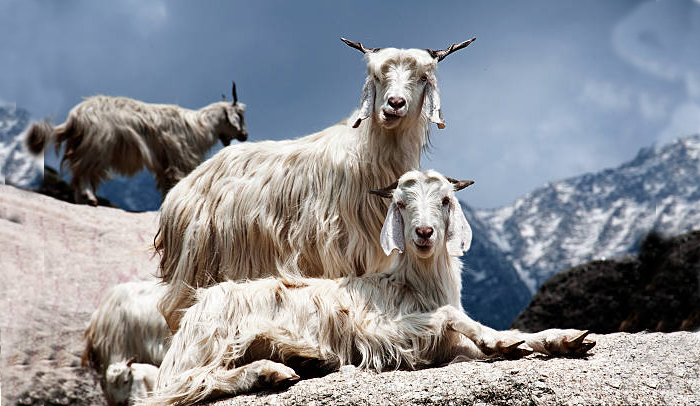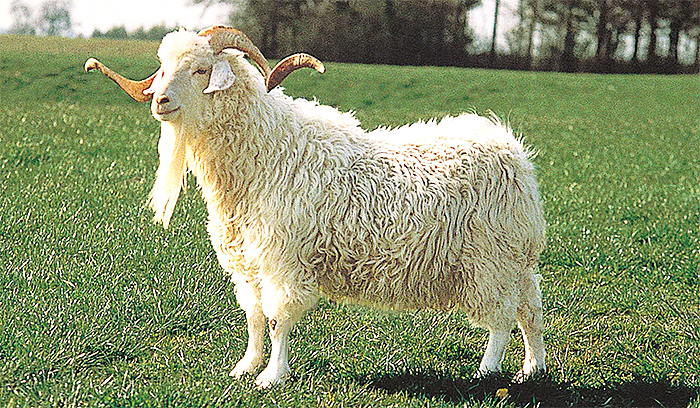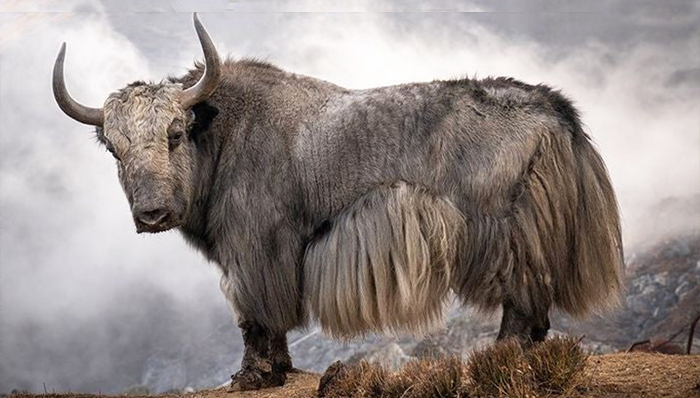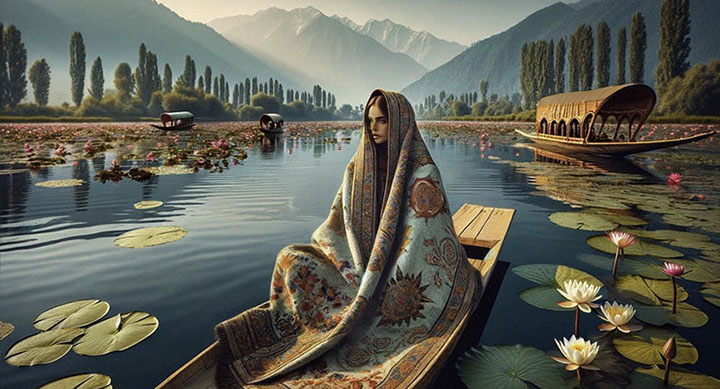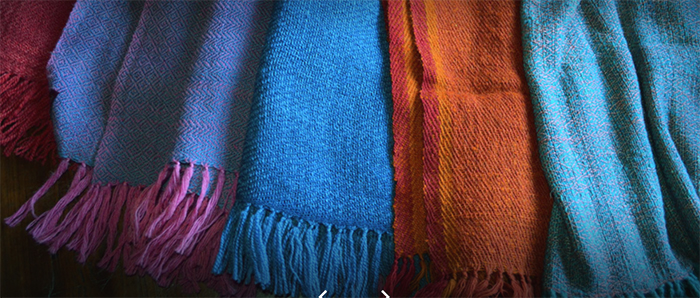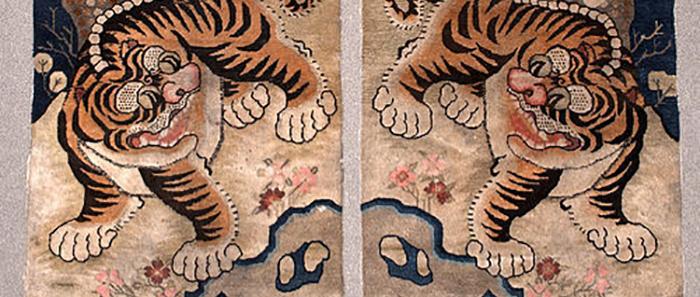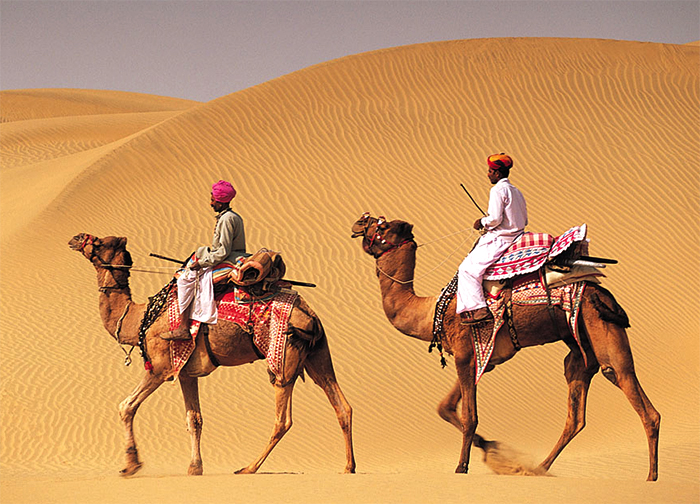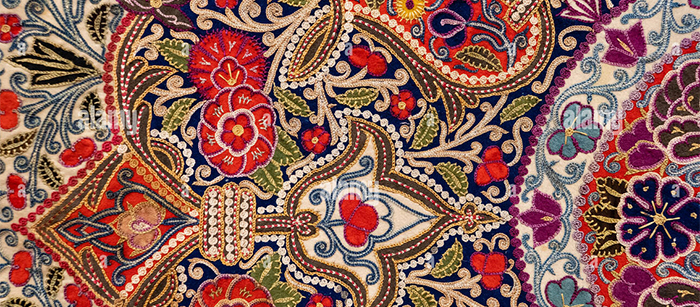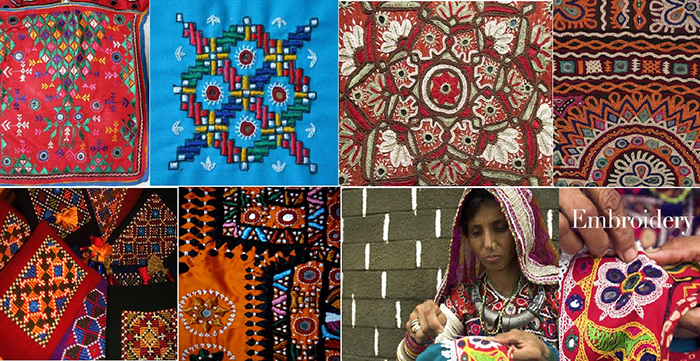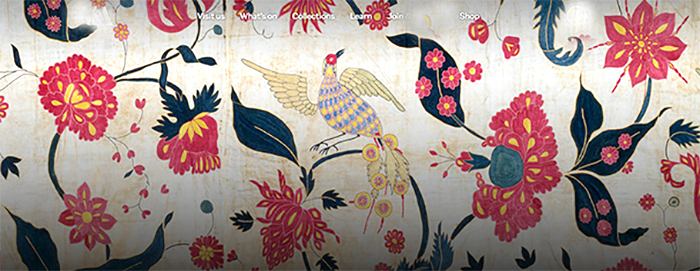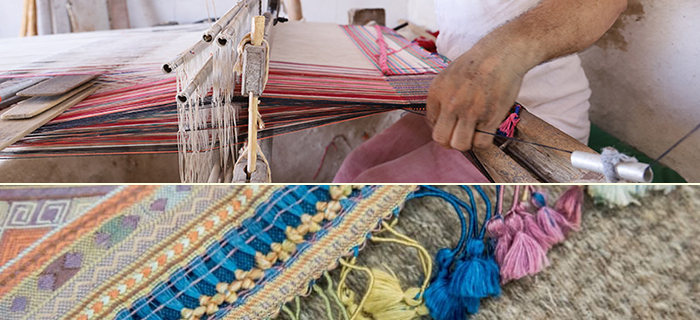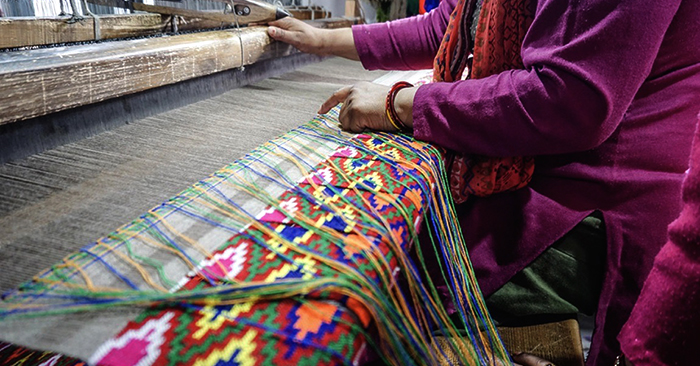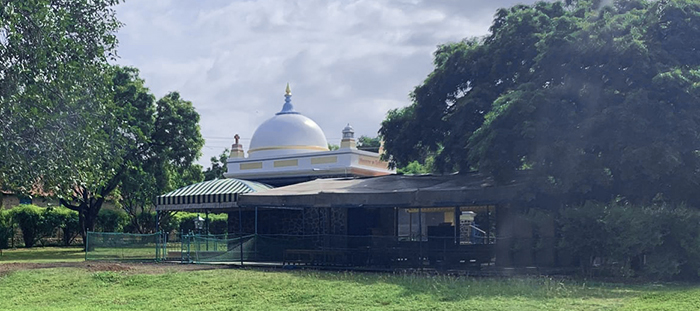INDIA WOOL

--------------------------------------
--------------------------------------
Sheep. Goat. Yak. Camel Indias' rich tradition of handmade woolen garments vary in style, design, and technique depending on the region in India and the community crafting them. Each region has its own unique techniques and styles, often hand-embroidered with intricate designs.
|
|
Sheep Wool Sheep herding for wool causes the least abuse of the wool animals. Wool is usually harvested once a year, in the spring. India is the seventh largest producer of wool in the world. The state that produces the largest amount of wool is Rajasthan.
Gaddi Sheep is one of the best indigenous sheep breeds in India. It is among the eight sheep breeds that live in the northern temperate regions of India. The fleece is fine, dense. The wool is used for making blankets and shawls. It is native to the Bhadarwah and Kishtwar regions of Jammu. It is also widely distributed in Uttarakhand and Himachal Pradesh. Gaddi is a breed of domesticated sheep. The Gaddi is raised primarily for its wool. Sheep are shorn twice or thrice in a year. The fleece is relatively fine and dense. Karnah Sheep, fine wool of India. Karnah sheep inhabit the Kupwara district of North Kashmir, along the line of control with Pakistan. The oldest breed in the Kashmir valley. Its' white wool has traditionally been used for making famous Kashmiri shawls and other woolen garments. The wool is of fine quality. The sheep are shorn twice a year, in spring and autumn. It is one of the endangered sheep breeds listed by the National Bureau of Animal Genetic Resources. Gurez Sheep, Bakharwal and Poonchi Sheep. produce greasy fleece as Karnah sheep produce as well. Resources of Jammu and Kashmir concluded that Kashmir Merino sheep have far higher production potential as compared to other sheep genetic resources. Kashmir Merino Sheep A synthetic strain developed in Jammu and Kashmir. a fast-growing and fine wool producing sheep strain, Kashmir Merino, was developed. Fodders scarcity during winters, lack of awareness among farmers, non-availability of proven sires, small flock size are major constraints in exploiting the genetic worth of Kashmir Merino sheep.
Rampur Bushair Sheep. is an important dual-purpose sheep in the north temperate Himalayan region of Himachal Pradesh. Breeding Tract: Kinnaur, Shimla, Lahul & Spiti. Breed is fairly widespread and a few numbers are found in the Uttarkashi. Animals are strong, well-built and of medium size with a square brow, mostly white, but black, brown and mottled are also found in good numbers. Typically a prominent Roman nose.
Kullu Shawls. Named after Kullu Valley, Himachal Pradesh, the Kullu woolens are one of the finest. Known for its reversible technique of weaving, in which same color and patterns are depicted on both sides. Patterned borders, the Kullu shawl is made from varieties of coarse local wool from sheep reared in the region. Featuring various geometrical patterns and bright colors. Originally, indigenous Kulivi people would weave plain shawls, but following the arrival of craftspeople from Bushahr in the early 1940s, the trend of more patterned shawls came to rise.
Kinnauri shawls stand apart with their exceptional intricacy and masterful weaving techniques that have garnered widespread admiration. Crafted from local sheep wool, these shawls are celebrated for their vibrant palette, intricate designs, and remarkable durability. Known for their intricate geometric designs, objects of religious importance are weaved on these shawls with colours of mythological origins. The colours used have a meaning with green signifying air, blue - ether, white - water, yellow standing for earth and red for fire.
Pashmina Goats Changthang is home of the Changas. About 170 km from Leh, upstream along the Indus. The narrow valley cradling the stream allows river waters to form a wide and spread out valley. It is mostly arid, wind-swept, cold and exposed to high levels of ultra-violet radiation. Sparsely populated, by people who migrated here in the 8th century. This region of a few villages and nomads, living in small groups along the Indus, migrate twice annually from summer grazing grounds to winter grazing grounds, within Changthang. The Changas: Livestock rearing is their main occupation and means of sustenance. Changra goats for Pashmina, amongst other animals, sheep etc. constitute their livelyhood. The animals are corralled, traps set up, youth sleep out in the open with Tibetan Mastiffs to thwart predation by wolves and snow leopards. In June after an eight-month-long winter, the Changpas collect Pashmina wool, which gives them cash to sustain them for the rest of the year. Men pin down one Pashmina goat at a time, upturn it, and run a long-toothed comb over the undercoat harvesting some Pashmina wool with each stroke. The fibre is traditionally sold by weight to traders from Leh. The traders scour, card and spin the fibre for shawls, the Kashmiris take the unprocessed fibres, and convert it into high quality cashmere fabric. Women who wear fine Pashmina shawls are seldom aware of the origins of Pashmina, or the travails endured by the people that nurture, tend and protect the mountain goats that yield this wool. If this traditional method would be all there is to it, it would all be very ethical but; there is considerable misuse in gathering pashmina wool. Many unscupulous gatherers search out goats in the mid of winter. It is very difficult to discern how the goats were treated and harvested. Many companies are ethical and responsible and many sources are not. The packets of goat wool used to make into yarn are often from unknown sources, individuals who pluck wool from goats in the winter, leaving the goats to freeze. -------------------------- More importantly: try not to buy shawls with angora rabbit blend in them, the angora rabbits are very cruelly treated. -------------------------- If it doesn’t feel very soft and itches once you wear it, you’ve got your hands on a fake one! This is because Pashmina is a hypoallergenic fibre. Hold it over a light. If it’s transparent, then it’s not real Pashmina. A 100 percent Pashmina scarf has been painstakingly handcrafted and will show some form of irregularities, since it’s done by hand. Synthetic fibres like acrylic and polyester when rubbed together generate static electricity as well as a little spark. Crafts Development Institute, Ministry of Textiles is part of Govt of India that certifies each Pashmina. Cashmere or Pashmina? It is the subspecies of the goat that makes the main difference between the Cashmere and Pashmina. Cashmere shawls are those that are made of the wools of the Himalayan goats but Pashmina is exclusively made from a specific breed of mountain goat called Capra Hircus. So, we can say that Pashmina is a variety of Cashmere. Due to the thin texture of the Pashmina, it is necessary to hand-spun the wool and manually weave them to make beautiful shawls with utmost care. On the other hand, Cashmere is easier to spin. Pashmina is softer and warmer than Cashmere. It is true that cashmere is also very soft and warm and it is more durable; but Pashmina is more comfortable to wear. Artisans of Kashmir still follow the years-old technique to spin the wool and weave by hand. On the contrary, Cashmere is machine spun. For that reason, Pashmina is more expensive than Cashmere. Cashmere goats are more often from regions like Mongolia, China, Iran, and Afghanistan. You can try himalayanweavers.org and pashmina.com Woolen Pashmina Blend: Crafted using a fusion of Pashmina wool and conventional sheep wool. This provides the cozy comfort and plushness of Pashmina, coupled with the ruggedness and cost-effectiveness of sheep wool.
Angora Goat - Mohair Mohair is considered a luxury fiber and should not be confused with Angora rabbit fiber. Mohair is as warm as wool although it is much lighter in weight. Mohair is also desirable due to its warmth, durability and beauty. Angora goats are bred primarily for their soft inner coats. Mohair is more expensive than standard sheep's wool. The Angora is generally smaller than other domestic goats and sheep. Both sexes are horned, and the ears are long and drooping. The strong elastic fiber of the coat differs from wool primarily in its smoothness and lustre. Angora goats have long locks of fiber cascading down each side. These goats require twice-yearly shearing for fiber and the goats’ best interest. Angoras, and fiber breed goats, cannot shed their coats. If they are not sheared or clipped, fiber can felt to the body and become worthless. It’s best to sheer angora goats twice yearly if they live in lower elevations. Some people prefer to comb the fiber off as it begins to release. Mohair is almost non-flammable. Early children’s Teddy Bears were made from mohair because of this property and because there is less allergic reaction to mohair than wool. ------------------------------------- Because of their tame nature, goats are ideally suited to being managed by village women and children. The Government of Rajasthan, Universities and international agencies undertake significant research and development in support of sustainable goat farming. This includes herd development, breed improvement and farmer education.
Yak The yak is a long-haired ox native to Himalayan high plateaus. Its wool has been used for thousands of years. Yaks and nomadic herders have partnered for centuries. Yak is a large bovine with a tan to a grayish-brown fur coat. Yak are gentle grazing animals, meaning they have soft footsteps. Their short tongues only remove the top of plants, whereas goats pull up the grass by the roots, so need constant new grazing fields. Yak live nomadically throughout the mountains. When looking at wool, 'khullu' is a sustainable alternative to cashmere. Yak fiber is one of the most sustainable wools. Yaks are healthier when their wool is combed out. Yak shed both strong, coarse guard fibers and soft insulating down fibers in the spring. The process of gathering khullu helps yak keep cool leading into the 90°F summers. Yak wool blends become more durable when mixed with quality sheep wool. Yak dark wool products are waterproof and may be dyed if required. Yak wool does not smell, it has amazingly hypoallergenic, antibacterial and antimicrobial properties. Over thousands of years, yaks have evolved to survive and thrive in the unforgiving high-altitude climate of the Himalayas. Yaks can live between 10,000 and 15,000 feet above sea level making them the highest-dwelling wool-bearing mammals in the world
Rabbits - Antelope Angora Rabbits . Very Cruel Treatment. The production of Angora wool, extracted from Angora rabbits, involves significant animal suffering, the hair is pulled out, not shorn. Despite its exceptional softness and warmth, garments like sweaters and shawls created from angora wool are mired in controversy due to the inherent cruelty associated with its manufacturing process. Sahtoosh Shawls: Chiru. UNLAWFUL. Now deemed unlawful. Shahtoosh shawls are crafted from the delicate wool of the Tibetan antelope, known as chiru. While these shawls boast remarkable softness and feather-light weight, they are exceedingly rare. It's crucial to underline that the production of shahtoosh has been prohibited due to ecological preservation concerns.
Kashmir Weaving & Embroidery Kani The kani sozni is an embroidery style where fine needlework lends the fabric the appearance of tapestry. Patterns—luscious flowers and twining leaves of chinar, paisley or ambi derive inspiration from the lush mountains and valleys of Kashmir. ---------------------------------- Kashmiri designer Zubair Kirmani's own unique design is Khatamband. His label Bounipun has a series of signature shawls and stoles, deep-rooted in tradition and at the same time modern and beyond the traditional craft. His collections have already found presence across fashion outlets in France, Spain and Italy. “As snow blankets the valley for the long months of winter, villagers confined indoors wove shawls, embroidering colorful patterns by hand before selling them in the spring” “The situation has changed a lot recently with most of our weaving families shifting to other professions.” ----------------------------------- Musoorie Wool
Musoori, a hill station, is a one hour drive up above Dehradun. In a small village outside Mussoorie the 'Himalayan Weavers of Masrana' live and work and promote the use of natural dyes on wool. This is a little shop, on the country-side, - away from Mussoorie, on the way to Dhanaulti. Great natural products, handmade from natural fibers and natural dyes. Interested in rural development, mountain agriculture and in the use of environment-friendly technologies, Ghayur and his wife Patricia decided to create a website for selling the products woven by the locals. They set up their base in village Masrana, which is between Dhanaulti and Mussoorie and thus was born their eco-friendly enterprise - Himalayan Weavers Dehradun wools Garhwali Kingdom was one of the few kingdoms that never came under the Muslim rule influence. The history of Garhwal is older than that of the Ramayana and Mahabharata. Worshipping Lord Shiva, according to the great Mahabharata, Garhwal is believed to be the land where the Vedas and the Shastras were made
Close to 2000 Tibetan people now reside in the area. Their main livelihood depends upon the traditional handicrafts of the Tibetan carpet, shoulder bags and woolen weavings like sweaters, socks and hats. Tibetan refugees in Dehradun are able to live well despite being refugees. There is a 'Tibetan Womens' Centre where refugees make hand knotted rugs and crafts. Nice shops in town. --------------------------------------- INDIA CONTENTS : JOURNEYS, FABRICS: SUPERSTRUCTURE ---------------------------------------
Camels Rajasthan Camel wool is used for clothing in the desert. About 70% of India's camels are found in Rajasthan, the vast majority of which are kept by the Raika. Camel wool is used for rough clothing in the desert. Rajastani spectrum of colors have been embraced creatively, adding to its reputation for producing exceptional woolen goods. The Raika represent one of the largest groups of livestock herders in India, they have managed to thrive in a harsh, semi-desert environment. The Unt Maldharis, or camel herders, of Kachchh tend a total population of over 10,000 camels. Pastoralism accounts for a large percentage of livelihoods in Kachchh. For many years, Maldharis were making camel wool for their own means, as coverings for their camels or for bags to carry their wares. There is an urgent need to enhance these livelihoods and to conserve the local camel populations. Khamir’s Camel Wool Project is one part of a multi-pronged response to these challenges. Camels produce high quality wool that is very warm, water-resistant and highly durable. It can be used to make textiles, carpets and ropes. Camels are sheared once a year. Camel wool is coarse and has short fibers, which poses challenges to both spinning and the production of soft, clothing appropriate textiles. --------------------------- Travel in Rajasthan: RAJASTHAN TRAVEL Tigers, Birds ---------------------------
Rajasthan Sheep Breeds in Rajasthan: Nail, Chokala, Malpura, Sonadi, Marwari, Jaisalmeri, Magra and Pugal. Chokala Sheep - The Merino Wool of India. Considered to be the best wool in India and Rajasthan, hence Chokala sheep is called the Merino sheep of India. Prized for its exquisite softness and finely textured fibers. This luxurious wool is frequently used in the crafting of premium woolen attire, such as sweaters, scarves, and socks. Chokala sheep are most commonly found in Rajasthan. North west of Jaipur. 'Mannavanur Bharat Merino' Sheep are being developed by crossbreeding indigenous Chokala and Nali sheep with Merino Rams. They have been distributed in Kolar District of Karnataka and the Thalavadi district of Tamil Nadu. Rajasthan The Raika began keeping sheep about 200 to 250 years ago. During this time they have influenced and developed the traits of their sheep by selective breeding and recently by cross-breeding with other breeds. In this way they have developed hardy breeds that are drought resistant, capable of walking long distances. Raika sheep and goat herds vary widely in size. Large herds are taken on migration for two to ten months. Marwari Sheep is an Indian breed of domestic sheep. It originates in, and is named for, the Marwar Rajasthan. The Marwari is a small sheep, It has a white body and a black face, no horns. The Marwari sheep is raised for its coarse wool, of carpet quality. Traditionally associated with camel breeding, a majority of Raika is currently engaged in herding sheep, often in migratory systems. The Raika depend on middlemen to market live animals and wool. In the wool market, the middlemen are also from the Raika community. For the less literate, unskilled and low income farmers, sheep farming is their main source of income. The Raika are a Hindu caste specialised in livestock breeding and at home in the Marwar area of Rajasthan. Sheep farming plays a major part in the economy of Rajasthan. The sheep are generally raised in small flocks of 30 t0 50 sheep. During the summer months the herds are migrated to neighboring states away from the arid regions. Sheep provide meat and wool products. They are used for weed control and for their rich dung as fertilizer for food crops. The Nitrogen and phosphoric acid are 2.5 times richer than in cow manure. Rajasthan: Ranakpur is a village located in Desuri tehsil near Sadri town in the Pali district, It is located between Jodhpur and Udaipur, The beautiful Maru Gurjara Art developed during the early sixth century period in and around Rajasthan. The ancient Rajasthani art had the genesis of its name from the ancient Rajasthan and Gujarat, both the states had very similar ethnic, cultural and political aspects. Maru Gurjara...‘Art of Rajasthan and Gujarat’. Rajasthan is the state which has made use of all the colors. Rajasthan is also famous for hand block printing. The remarkable and magnificent combination of pink, red, orange and purple, . The specialty of Rajasthan block printing is floral print and pattern which are prepared with vegetable color. Of the 862 spinning mills in India, 69 spinning mills are in Rajasthan.
Mirror embroidery in KachchhKutch district, officially spelled Kachchh, is a district of Gujarat state in western India, with its headquarters (capital) at Bhuj, it is the largest district of India. The northern boundary of the Rann of Kutch forms the International Border between India and Pakistan. Kachchh is renowned for its mirrored embroideries. Traditionally stitched by village women to create festivity, honor deities, or generate wealth. While embroideries contributed to the substantial economic exchange required for marriage they were never commercial products. The “mirror work” of Kachchh is really a myriad of styles, which present a richly textured map of regions and ethnic groups. -------------------------------------
Travel in Rajasthan: RAJASTHAN TRAVEL Tigers, Birds -------------------------------------
Bujodhi wools Bhuj, city is situated in the lowlands between the Rann (marsh) and the Gulf of Kachchh (Kutch). The Aina Mahal, a palace built by Rao Lakhpatji in the 18th century and now a museum. The village of Bhujodi in Gujarat's Bhuj region is called the 'weaver village' as there is a loom in every house. Men, women, and children are all engaged in the process of weaving in this 500-years-old village.
By 6am, the sounds of the looms take over the morning silence. More than 350 weaver families start making shawls, stoles, sarees and dress materials for national and international buyers before the first rays of the sun touch the village in Bhuj. Weavers of the Vankar community migrated from Rajasthan to Gujarat hundreds of years back. The Rabaris, who already lived in Kutch, had access to sheep wool and excelled in embroidery. But they did not possess weaving skills. Thus began their association with the Vankar community members, who would weave dhabla shawls used by Rabaris during the cold winter months. And the craft came to be known as dhabla weaving, now famous across the world for its traditional weave and natural colours.
Dhabla, the graceful weaving of the deserts, natural colours were used to produce the traditional Dhabla, The Rabari women would meticulously weave a Dhabla- a conventional blanket worn by the males of the hamlet- until it was finished. The Dhabla was historically constructed of single and two-ply wool and was rather heavy. Due to its delicate patterning, raindrops could not penetrate the cloth. Males also wore the Dhabla to keep them comfortable throughout the day. In 1965 when Mumbai-based designer Prabha Shah visited the village and saw the craft. She was in awe of their designs and helped Shamji’s father Vishram Valji set up an exhibition in Mumbai. That was the family’s first opportunity to understand urban tastes and requirements. The Valji family began to make shawls for city dwellers using soft and light merino wool. The traditional designs in the red, indigo, beige and natural browns were loved by the buyers and the family began to receive orders. The word spread and there was no looking back. Travel in Rajasthan: RAJASTHAN TRAVEL Tigers, Birds -------------------------------- Ahmedabad Saris weavers: Ahmedabad’s Ashavali sarees Recently, they have associated with Gujarat State Handloom and Handicraft Development Association to promote the craft. --------------------------------
Rajasthani hand weaving. Jaipur The rural countryside around Jaipur is well-suited to goat herding, with its open grazing system. Herders keep their flocks moving so they can forage along open roads and manage the risk of over-grazing. Farmers move their sheep with the assistance of a few goats. A goat will often be in the lead, following the farmer with the sheep following the goat. Other men will be walking alongside the flock keeping it moving, again with the help of a goat. -------------------------------------
MARWAN wool: Most disease resistant. Very drought resistant. Has long life. Can withstand lack of food. Wool is soft and thin. SONADI wool: Needs good food and water. Not good for migration. Selective eater. Wool is course. Good milk. Grows fast. PATANWADI wool: From North Gujarat. Fast walker. Eats everything. Wool is long and soft and fine. Grows fast. Bakharwal Sheep are entirely migratoray and have no distinct home tract. They may be found in the Pir Panjal ranges of the Jammu division during winter and migrate to the Kashmir Valley during summer. Fleece is course and open used for making carpets. Nilgiri Sheep District of Tamil Nadu, in southern IndiaIt is said to have evolved in the 19th century and comes from a cross-breed with an unknown origin. The wool that this native Indian breed of sheep yields is used to make carpets. The sheep are maintained for their manure by flock owners and tea planters, but they are facing extinction. There is a national plan that is being implemented to conserve this breed of sheep. ----------------------------------- INDIA COTTON ----------------------------------- SILKS and SARI Varanasi's famous Silk Wedding Sarees. ----------------------------------- INDIA - CHIKAN - LINEN ------------------------------------- All Articles and website designed by elenagh@live.com -------------------------------------
Avatar Meher Baba Samadhi - Tomb Shrine. Meherabad Meher Babas' Samadhi can be visited directly from either Pune or Ahmednagar. You need to hire a car with a driver who knows how to drive to the parking up the hill, near the Samadhi. Open to everyone from 7 am to 7 pm. Information about Meher Baba: https://avatarmeherbabatrust.org/ |
| Avatar in India Index | ||||
VISIT INDIA --------------------------- |
VISIT INDIA ---------------------------- |
VISIT INDIA --------------------------- |
||
| • HIMALAYAN VALLEYS | ||||
|
